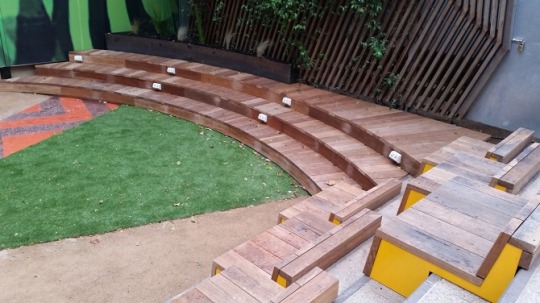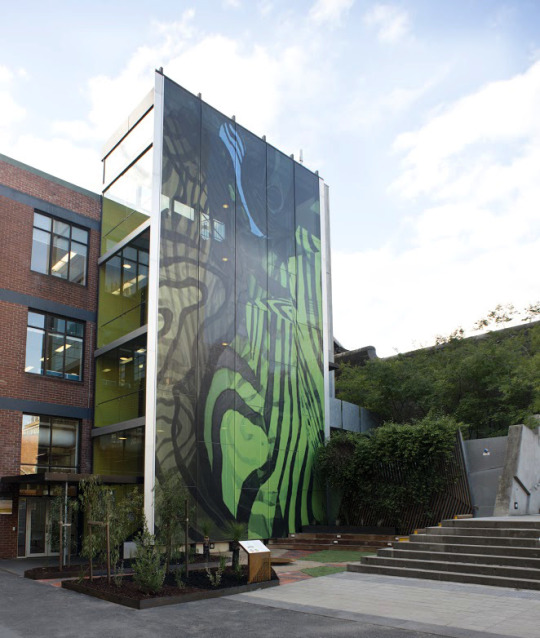#Ngarara Place
Photo




Making a significant cultural contribution to RMIT University’s Melbourne campus, Ngarara Place provides a “visible presence and recognition of Aboriginal and Torres Strait Islander peoples, cultures and histories as connected among the lands of the Kulin Nation”. Designed by Greenaway Architects, its arrangement rests upon four distinct principals, each referencing the university’s important direct and indirect connections to Indigenous culture.
Located at a key intersection of the university, Greenaway Architects' first principal for Ngarara Place was ensuring the link between Indigenous culture and ‘connection to country’. This is achieved through establishing a clear connection between the site’s seven distinct sections and the Kulin people’s recognition of seven seasons. While each section serves a different function, like space for dance, ceremonial activities and tiered planting, Ngarara Place’s centrepiece is a sculptural smoke pit.
The inclusion of local Indigenous art and tradition is seen through cultural motifs and contemporary Indigenous art. Many of the site’s motifs reflect nation groups from the Australia’s southeast (as seen in the pavement design and carving by Indigenous landscape designer Charles Solomon), while Weilwan/Gomeroi artist Aroha Groves produced the large vertical glazed facade. Finally, Ngarara Place serves as a knowledge exchange with several endemic and Indigenous species of plants and educational signs giving context to the history and ritual conceived throughout the site’s design.
As described by Greenaway Architects: “The landscape reinforces and reveals layers of history and meaning through an active gesture of reconciliation, while infusing Indigenous sensibilities within the heart of the City of Melbourne and begins to broader the frame of reference in which people can connect to place.”
Photographs by Moorina Bonini and Peter Casamanto, via Greenaway Architects.
#RMIT University#Greenaway Architects#Ngarara Place#Indigenous Art#Placemaking#City of Melbourne#Contemporary Art#Kulin Nation#Tradition#Motifs#Aroha Groves#Charles Solomon
1 note
·
View note
Photo






2019
TIMeR
Augmented Reality Pervasive Game
RMIT, Melbourne Australia.
Exploring the multiple, multisensorial and contested modes of making place, TIMeR features stories of land, river and sky with Boonwurrung elder N'Arweet Carolyn Briggs. Participants will be transformed into wayfarers as they move across the RMIT campus to uncover alternate cartographies, bringing new insights to familiar routes. Premiered during the Engaging for Impact 2019 event, the TIMeR prototype will be available to download and play from www.rmittimer.net
You can participate by visiting: www.rmittimer.net
TIMeR is produced by DCP post-doc Hugh Davies, in collaboration with Associate Professor Olivia Guntarik, Boonwurrung elder N'Arweet Carolyn Briggs and VC Research Fellow Dr Troy Innocent. The project is developed with collaboration from Prof Mark McMillan (DPVC, Indigenous Engagement and Education), and the Ngarara Willim Centre, Elders in Residence.
TIMeR is generously supported with funding from the Design and Creative Practice Enabling Capability Platform and RMIT Research.
0 notes
Photo

Ngarara Place, the Indigenous courtyard in #RMIT’s City campus, by Greenaway Architects 2016. The supersize artwork has just been renewed, this one by Marcus Lee, a graphic artist and proud descendant of the Karajarri people in Northern Western Australia. (at RMIT University) https://www.instagram.com/p/B6DJz9aH4S2/?igshid=16rzylm597stu
0 notes
Photo





WEEK 7
To start our class, we met at Ngarara Place, an Indigenous garden within RMIT.
While the space is overall quite nice and peaceful, we discussed about how it seems like a slightly odd spot, as people sitting there are looking at the back of the buildings covered in pipes and electrical wiring.
0 notes
Photo

WEEK 7 NGARARA PLACE, LECTURE 3
We visited Ngarara Place on campus and discussed what we thought about the location and layout of the garden as it was in an area with a fairly large amount of foot traffic. We thought that having the gardens meters away from the buildings disrupted the flow and overall atmosphere of the garden. There was also constant noise pollution around us which also affected the atmosphere a bit. Despite all this, it was nice to sit there and relax, as it was such a nice day too!
LECTURE 3 BUNDYI GIRRI
Bundyi Girri is about non-Indigenous people coming to a understanding of a sovereign relationship with Indigenous sovereignty. As he was talking, I started to realise how little I knew about Indigenous culture. Near the beginning of the lecture, he asked us all this question: ‘Do you know who the traditional owners/custodians of this land are?’ and only one person raised her hand. It made me realise that I really quite naïve in terms of understanding the importance of place for Indigenous people, and Indigenous culture in general. He also talked about the Kulin Calendar that we saw at Ngarara Place, that is dependent on place, and the seasons are all depends on what happens in the environment. I realised that this really connects to a sense of place.

0 notes
Photo







Week 7
Ngarara Place is a significant addition to the cultural and campus life of RMIT. In recognition of the oldest continuing culture in the world, a newly conceived landscape/urban design intervention has been incorporated adjacent to the key cross access (of Chemistry Lane) within the heart of RMIT’s city campus. - from RMIT website
Today we have been to the Ngarara Place near building 15 to look at the design of this space. The design concept was inspired by the Aboriginal seasons, which is a very interesting thing to me. I never knew about this sort of system until I saw this. This is a nice place for students and teachers to rest and chat. To be honest, when I was sitting there, a group of tiny insects were flying actively above my head that made me feel uncomfortable. That’s the only thing that I was not happy with, otherwise I really like that place. It provides a place for people stay and it is good looking. I want to set fire in the fireplace (I like the patterns!) to see the whole effect of the design. I would be really cool. On the other hand, the glass wall fit the place well because it got Aboriginal elements in it. The plants are unique as well, like the little trees which are still growing. They are so cute. In conclusion, I think this is a nice designed space. It’s such a pity that not many people notice about this place.
0 notes
Text
TDF Talks with Architect, IADV Co-founder, and Academic Jefa Greenaway
TDF Talks with Architect, IADV Co-founder, and Academic Jefa Greenaway
Podcast
by Lucy Feagins, Editor

Koorie Heritage Trust images at Federation Square. Photo – Peter Bennetts.

Left: Koorie Heritage Trust images at Federation Square. Photo – Peter Bennetts. Right: Ngarara Place image at RMIT. Photo – Peter Casamento.
Jefa Greenaway is more than aware of the weight of responsibility that comes with being one of a minority of Indigenous architects working in Australia today, and he’s become a brilliant advocate for indigenous voices within the built environment.
Interviewing Jefa very quickly throws into focus the glaring lack of diversity with the Australian design community. For example, right now, Jefa estimates that there are probably between 6 and 8 registered indigenous architects in private practice nationally, and at most, he estimates that around 20 indigenous people have graduated from schools of architecture nationally, ever.
Despite these discouraging numbers, Jefa is optimistic, and the good news is, things are improving. Somewhere between 50-70 students of an indigenous background are in schools of architecture nationally right now – and the IADV, a not-for-profit organisation which Jefa co-founded, provides services to support those students and ensure they flourish.
What Jefa is seeking to do, is to move beyond what he calls the ‘deficit discourse’ of how we engage with indigenous culture. Instead, he is focussed on celebrating our shared humanity and shared connections. Because as he says, ‘we are all connected to the oldest continuing living culture in the world – so why wouldn’t we seek to look at the strength and the opportunity that that can bring?’
I found this conversation so enlightening, and I’m so grateful to be able to share just a little of Jefa’s wisdom with you via this podcast.
Notes and Links
Jefa’s architectural practice is Greenaway Architects.
One of Jefa’s most notable recent projects was the refurbishment of the Koorie Heritage Trust at Federation Square.
Jefa co-founded not-for-profit organisation Indigenous Architecture and Design Victoria (IADV) a decade ago.
Last year, Jefa curated Blak Design Matters, the first the first national survey of Australian Aboriginal and Torres Strait Island design – we wrote a little story about it here.
One of Jefa’s most valuable projects over the past decade has been the creation of the International Indigenous Design Charter (IIDC), which is a framework that design practitioners can follow in order to engage in responsible design practice, as it relates to first nations people.
Jefa’s upcoming speaking events include :
Participation in a panel on Decolonising the Public Realm, at Monash University Museum of Art (MUMA) 30st – 31st.
‘Delight’ – the AIA 2019 QLD Regional Conference, Cairns, Queensland 24th – 26th October.
‘Object Subject’: the 2019 National Design Writing Conference, ANU Canberra, 7th – 10th November.
SDNow 4 Conference at RMIT University, on the 14th – 16th November.
This is the 33rd episode of our TDF Podcast – thanks so much for listening! You can browse all or revisit any episode here.
0 notes